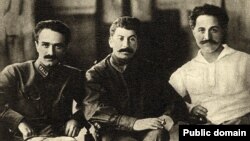The municipal authorities in Yerevan have announced controversial plans to erect a monument to Anastas Mikoyan, an ethnic Armenian leader of the Soviet Union and close associate of Joseph Stalin.
Earlier this week the city’s municipal council allowed Mayor Taron Markarian’s office to place Mikoyan’s statue in a park in downtown Yerevan.
The municipality gave no clear explanation for the decision which is prompting growing criticism from Armenian civil society members. They point to Mikoyan’s role in the Stalin-era mass executions and imprisonments of people across the ex-USSR.
Born in a village in northern Armenia in 1895, Mikoyan joined Stalin’s Politburo in 1935 and held other senior positions in Moscow during the Soviet dictator’s long rule. He inevitably played a part in Stalin’s “great purge” resulting in the deaths of millions of people. Some historians say, though, that he advocated leniency towards some prominent members of the Communist Party.
Mikoyan was infamously dispatched to Soviet Armenia in 1937 to oversee purges among local Communists and intellectuals. In a September 1937 letter publicized after the Soviet collapse, the then chief of the NKVD, the notorious Soviet secret police, informed Stalin that Mikoyan is asking him for permission to execute an additional 700 “anti-Soviet elements.”
Hayk Demoyan, a pro-government member of Yerevan’s Council of Elders, cited this and other “controversial facts” related to Mikoyan before voting against the proposed statue. Three other members, who are affiliated with the opposition Barev Yerevan bloc, also came out against it.
But the other councilors representing the ruling Republican Party of Armenia (HHK) and the Prosperous Armenia Party (BHK) voted for the statue.
The decision was recommended beforehand by the council’s committee on culture and education on the basis of an explanatory note submitted by the municipal government. Tamara Poghosian, the committee chairwoman, told RFE/RL’s Armenian service (Azatutyun.am) that the document made no reference to Mikoyan’s involvement in the Stalin-era purges.
Asked whether she herself is aware of that involvement, Poghosian said, “I’m not a historian and don’t have such information.”
“Why are we now putting a statue of a man who supported summary executions of Armenians?” asked Anahit Bakhshian, one of the Barev Yerevan councilors who voted against the monument. She said the Armenian authorities are thereby sending a wrong message to the nation.
Amatuni Virabian, the director of Armenia’s state archives, also spoke out against the statue, saying that there is ample documentary evidence of Mikoyan’s involvement in the atrocities. “I believe that those who went through 1937 must not have statues erected or streets named after them,” he told RFE/RL’s Armenian service (Azatutyun.am). “We must simply leave those people alone. They had no choice.”
Despite signing death lists in the 1930s and 1940s, Mikoyan supported Soviet leader Nikita Khrushchev’s historic 1956 speech that denounced Stalin’s personality cult and atrocities. Mikoyan remained a Politburo member even after Khrushchev was deposed in 1964. He was the Soviet Union’s nominal head of state in 1964-1965.
Earlier this week the city’s municipal council allowed Mayor Taron Markarian’s office to place Mikoyan’s statue in a park in downtown Yerevan.
The municipality gave no clear explanation for the decision which is prompting growing criticism from Armenian civil society members. They point to Mikoyan’s role in the Stalin-era mass executions and imprisonments of people across the ex-USSR.
Born in a village in northern Armenia in 1895, Mikoyan joined Stalin’s Politburo in 1935 and held other senior positions in Moscow during the Soviet dictator’s long rule. He inevitably played a part in Stalin’s “great purge” resulting in the deaths of millions of people. Some historians say, though, that he advocated leniency towards some prominent members of the Communist Party.
Mikoyan was infamously dispatched to Soviet Armenia in 1937 to oversee purges among local Communists and intellectuals. In a September 1937 letter publicized after the Soviet collapse, the then chief of the NKVD, the notorious Soviet secret police, informed Stalin that Mikoyan is asking him for permission to execute an additional 700 “anti-Soviet elements.”
Hayk Demoyan, a pro-government member of Yerevan’s Council of Elders, cited this and other “controversial facts” related to Mikoyan before voting against the proposed statue. Three other members, who are affiliated with the opposition Barev Yerevan bloc, also came out against it.
But the other councilors representing the ruling Republican Party of Armenia (HHK) and the Prosperous Armenia Party (BHK) voted for the statue.
The decision was recommended beforehand by the council’s committee on culture and education on the basis of an explanatory note submitted by the municipal government. Tamara Poghosian, the committee chairwoman, told RFE/RL’s Armenian service (Azatutyun.am) that the document made no reference to Mikoyan’s involvement in the Stalin-era purges.
Asked whether she herself is aware of that involvement, Poghosian said, “I’m not a historian and don’t have such information.”
“Why are we now putting a statue of a man who supported summary executions of Armenians?” asked Anahit Bakhshian, one of the Barev Yerevan councilors who voted against the monument. She said the Armenian authorities are thereby sending a wrong message to the nation.
Amatuni Virabian, the director of Armenia’s state archives, also spoke out against the statue, saying that there is ample documentary evidence of Mikoyan’s involvement in the atrocities. “I believe that those who went through 1937 must not have statues erected or streets named after them,” he told RFE/RL’s Armenian service (Azatutyun.am). “We must simply leave those people alone. They had no choice.”
Despite signing death lists in the 1930s and 1940s, Mikoyan supported Soviet leader Nikita Khrushchev’s historic 1956 speech that denounced Stalin’s personality cult and atrocities. Mikoyan remained a Politburo member even after Khrushchev was deposed in 1964. He was the Soviet Union’s nominal head of state in 1964-1965.
